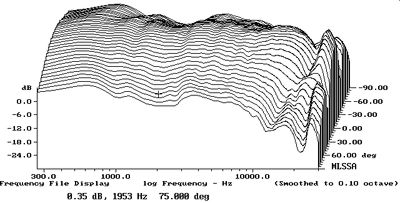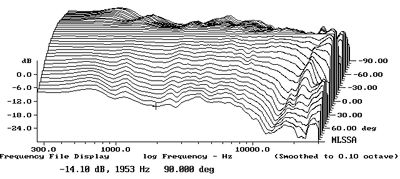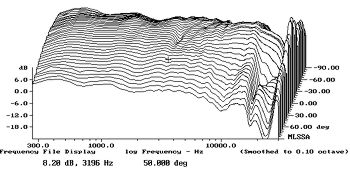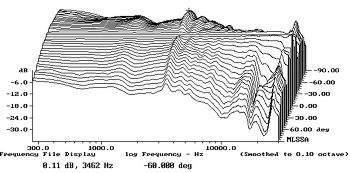I lusted after Ditton 66s in 1979 but they were w-a-y out of my price range ( I had Wharfedale 8" RS/DD in DIY cabinets)IIRC the Ditton 66 was first released in '68. So that is oooooold haha.
-
WANTED: Happy members who like to discuss audio and other topics related to our interest. Desire to learn and share knowledge of science required. There are many reviews of audio hardware and expert members to help answer your questions. Click here to have your audio equipment measured for free!
You are using an out of date browser. It may not display this or other websites correctly.
You should upgrade or use an alternative browser.
You should upgrade or use an alternative browser.
Klipsch R-41M Bookshelf Speaker Review
- Thread starter amirm
- Start date
- Joined
- Jun 19, 2018
- Messages
- 6,652
- Likes
- 9,410
I lusted after Ditton 66s in 1979 but they were w-a-y out of my price range ( I had Wharfedale 8" RS/DD in DIY cabinets)
From what I understand, the tweeter was much hyped, is that right? And do you remember how much they cost back then?
How were the Wharfedales? Did you use a passive filter to bring the frequency response into line?
- Thread Starter
- #463
I spoke of no preference. I spoke of critical listening to identify what is there. It is either no audible difference, or brightness. And that is what the science predicts as far as harmonic distortion creating more high frequency content.I am not questioning your listening ability.
But the keyword here is "I".
You have have yet to hear any distortion that is pleasing (to yourself).
That is your preference, your taste. You can't extrapolate your preference to other people.
This is in sharp contrast with countless audiophiles with no critical listening ability, or performance of controlled tests, saying this and that sounds warm to them and hence the reason they like it. They would most definitely flunk any controlled blind AB test to tell the difference let alone have a preference.
The preference is coming from their eyes and brains, not the sound they are able to detect.
- Thread Starter
- #464
The B&W 802 is a fixture in Harman studies with a directivity dip and loses to other for that very reason. I have. Until then, you don't know that you like such a dip since the rest of the performance of a speaker impacts you as well.I have mentioned a distortion that I found pleasing, a broad dip of about 2dB in a pair of loudspeakers.
I don't remember how much they were. I was impressed by the bass. (I am still surprised people seem less bothered by missing the lowest octave, which I enjoy) and get obsessed about the highest octave (much of which I can't hear and only contains overtones of the sort of music I prefer).From what I understand, the tweeter was much hyped, is that right? And do you remember how much they cost back then?
How were the Wharfedales? Did you use a passive filter to bring the frequency response into line?
I think the Celestion dome drivers were SOTA then.
The Wharfedales were way better than anything I had before. I built a pair of KEFkit3s a year or two later, which is where I first suspected how important cabinet talk must be.
tuga
Major Contributor
I spoke of no preference. I spoke of critical listening to identify what is there. It is either no audible difference, or brightness. And that is what the science predicts as far as harmonic distortion creating more high frequency content.
This is what you said:
When I tell you that I have yet to hear any distortion that is pleasing, or give "warmth: to music, it is a highly reliable data point.
Maybe I misunderstood what you meant by "pleasing".
tuga
Major Contributor
The B&W 802 is a fixture in Harman studies with a directivity dip and loses to other for that very reason. I have. Until then, you don't know that you like such a dip since the rest of the performance of a speaker impacts you as well.
I have listened to several iterations of the 802, which ones are those?
I even had a pair of older 802 Matrix S3s for a bit. Awful ear-bleeders...
tuga
Major Contributor
The 801F and ensuing Matrix models were much better in that regard:

B&W Matrix 801, lateral response family at 50", from back to front:
responses 90 degrees-5 degrees off-axis, reference response on tweeter axis,
responses 5 degrees-90 degrees off-axis.

B&W Matrix 801, lateral response family at 50", normalized to response on tweeter axis, from back to front:
differences in response 90 degrees-5 degrees off-axis, reference response, differences in response 5 degrees-90 degrees off-axis.

B&W Matrix 801, lateral response family at 50", from back to front:
responses 90 degrees-5 degrees off-axis, reference response on tweeter axis,
responses 5 degrees-90 degrees off-axis.

B&W Matrix 801, lateral response family at 50", normalized to response on tweeter axis, from back to front:
differences in response 90 degrees-5 degrees off-axis, reference response, differences in response 5 degrees-90 degrees off-axis.
Last edited:
tuga
Major Contributor
Revel Ultima1 Studio for comparison:

Revel Ultima Studio, lateral response family at 50", from back to front:
responses 90 degrees-5 degrees off-axis, reference response on tweeter axis,
responses 5 degrees-90 degrees off-axis.

Revel Ultima Studio, lateral response family at 50", normalized to response on tweeter axis, from back to front:
differences in response 90 degrees-5 degrees off-axis, reference response, differences in response 5 degrees-90 degrees off-axis.

Revel Ultima Studio, lateral response family at 50", from back to front:
responses 90 degrees-5 degrees off-axis, reference response on tweeter axis,
responses 5 degrees-90 degrees off-axis.

Revel Ultima Studio, lateral response family at 50", normalized to response on tweeter axis, from back to front:
differences in response 90 degrees-5 degrees off-axis, reference response, differences in response 5 degrees-90 degrees off-axis.
- Joined
- Jan 15, 2020
- Messages
- 6,909
- Likes
- 16,992
Yes, there was a big change at the approach/target of B&W engineering/voicing around early 00s, before they used high order filters and had very good measurements and later they concentrated more on low order filters but anyway the market didn't punish that new direction but they still were very successful.
Another example, the early 2000s entry DM603 S3

(source https://www.stereophile.com/content/bw-dm603-s3-loudspeaker-measurements)
vs. its newer successor 683 S2

(source: https://www.stereophile.com/content/bowers-wilkins-683-s2-loudspeaker-measurements)
or current more expensive series 702 S2

(source https://www.stereophile.com/content/bowers-wilkins-702-s2-loudspeaker-measurements)
or current high end 802 D3

(source https://www.stereophile.com/content/bowers-wilkins-802-d3-diamond-loudspeaker-measurements)
Maybe it was also related of to the the leaving of B&Ws executive director Robert Trunz and chief engineer Laurence Dickie (the one who also designed the legendary and still produced Nautilus) and creating their own company Giya Audio which makes newer and smaller "Nautilus":

(source: https://www.stereophile.com/content/vivid-audio-g1giya-loudspeaker-measurements)
Another example, the early 2000s entry DM603 S3
(source https://www.stereophile.com/content/bw-dm603-s3-loudspeaker-measurements)
vs. its newer successor 683 S2
(source: https://www.stereophile.com/content/bowers-wilkins-683-s2-loudspeaker-measurements)
or current more expensive series 702 S2
(source https://www.stereophile.com/content/bowers-wilkins-702-s2-loudspeaker-measurements)
or current high end 802 D3
(source https://www.stereophile.com/content/bowers-wilkins-802-d3-diamond-loudspeaker-measurements)
Maybe it was also related of to the the leaving of B&Ws executive director Robert Trunz and chief engineer Laurence Dickie (the one who also designed the legendary and still produced Nautilus) and creating their own company Giya Audio which makes newer and smaller "Nautilus":
(source: https://www.stereophile.com/content/vivid-audio-g1giya-loudspeaker-measurements)
- Thread Starter
- #472
You did misunderstand. I am assessing the nature of the distortion. Not telling you what I like or dislike as you positioned.This is what you said:
Maybe I misunderstood what you meant by "pleasing".
Oh, didn’t know that. Giya’s Vivid models are the only esoteric designs I know of that actually measure well.Maybe it was also related of to the the leaving of B&Ws executive director Robert Trunz and chief engineer Laurence Dickie (the one who also designed the legendary and still produced Nautilus) and creating their own company Giya Audio
tuga
Major Contributor
You did misunderstand. I am assessing the nature of the distortion. Not telling you what I like or dislike as you positioned.
You've never heard a distortion that you found pleasing. You never enjoyed the effect of any distortion. That is a matter of taste, isn't it? Your personal preference?
Isn't that what Toole's research regarding speaker tonal balance preference was all about?
- Thread Starter
- #475
No, no, no.You've never heard a distortion that you found pleasing. You never enjoyed the effect of any distortion. That is a matter of taste, isn't it? Your personal preference?
Isn't that what Toole's research regarding speaker tonal balance preference was all about?
tuga
Major Contributor
Oh, yes.No, no, no.
SynthesisCinema
Active Member
- Joined
- Oct 2, 2019
- Messages
- 173
- Likes
- 227
Hi all. Very good discussion. I would like to add my own subjective opinion, as I owned Klipsch RP-280f speakers. I had them for 2 years, so I had enough time to listen and I would agree with general statements in this review. My speakers had a spike at around 2-3kHz which made them sound very bright, harsh and with lots of sibilants on highs. I could not listen them for more than 30min, I was getting tired. Another issue with sound tonality was that they had drops on the curve at around 250Hz and that drop make them sound very thin with really bad sound stage. So, generally I was very unhappy with sound and I sold them and bought Polk Audio Lsim 705, which is much better and very pleasant to listen. Sorry for this small offtop, i just thought it is the same reference series and from what I read in this review it seems to be a similar sound.
The new RP serie shouldn´t be bright. James`s comments from the new version of RP-280F = RP-8000F. " The first thing to note is how remarkably flat the direct axis response is. For all of Klipsch’s reputation of having sizzling hot treble, it just isn’t here. This is a very neutral response. In fact, in my listening, I wouldn’t have characterized the speaker as ‘bright’, although not ‘warm’ either. It sounded neutral to my ears, and that is basically what is being displayed in these measurements. "
https://www.audioholics.com/tower-speaker-reviews/klipsch-rp-8000f/conclusion
Looking forward what @amirm thinks about the RP-600M when he get´s them.
I am intrigued why people think titanium may be better than aluminium, particularly anodised aluminium, as a tweeter dome material.The titanium tweeter over aluminum
The specific stiffness is the same for both, so unlikely to have higher breakup frequency.
Beryllium would be obviously be better in being pistonic to a higher frequency but anodised aluminium will be better than titanium, based on its mechanical properties.
I am frequently mystified by the use of titanium. Whilst it is a brilliant engineering material for some uses, I have used it a lot, the daftest was some camping cookware. As metals go titanium has a very poor thermal conduction (we use it to mount the brake discs on racing cars to reduce heat transfer to the wheel bearings) so for cookware it is a stupid choice (aluminium is less dense and cheaper).
Maybe it is a bit like some hifi, more expensive must be better.
- Joined
- Jun 19, 2018
- Messages
- 6,652
- Likes
- 9,410
I am intrigued why people think titanium may be better than aluminium, particularly anodised aluminium, as a tweeter dome material.
The specific stiffness is the same for both, so unlikely to have higher breakup frequency.
Beryllium would be obviously be better in being pistonic to a higher frequency but anodised aluminium will be better than titanium, based on its mechanical properties.
I am frequently mystified by the use of titanium. Whilst it is a brilliant engineering material for some uses, I have used it a lot, the daftest was some camping cookware. As metals go titanium has a very poor thermal conduction (we use it to mount the brake discs on racing cars to reduce heat transfer to the wheel bearings) so for cookware it is a stupid choice (aluminium is less dense and cheaper).
Maybe it is a bit like some hifi, more expensive must be better.
Following from that, and notwithstanding the clear theoretical advantages of beryllium, I'm not sure I see any practical benefits of its use in direct radiating dome tweeters.
A standard 1" dome is already beaming significantly at the top of the audio band, and the break-up frequency of more conventional materials (e.g. aluminium) is already typically above the top of the audio band for a diaphragm of that size.
In other words, the maximum size of a dome is limited not by its break-up frequency, but rather by its directivity characteristics. Yes, you could make a beryllium tweeter larger and still keep its break-up outside the audio band, but why would you want to? 1" is already too large for a direct radiating dome (if we have any interest in off-axis dispersion in the high frequencies).
Or @Frank Dernie is there some other reason why beryllium might still be a better choice, even at 1" diameter or smaller?
The only gain is the stiffness to density ratio which is superior to all other metals apart from boron which has manufacturing limitations.Or @Frank Dernie is there some other reason why beryllium might still be a better choice, even at 1" diameter or smaller?
Anodised aluminium is inexpensive and, if you affirm it is pistonic to 20kHz as a 1" dome, good enough.
Similar threads
- Replies
- 338
- Views
- 49K
- Replies
- 245
- Views
- 39K
- Replies
- 6
- Views
- 2K
- Poll
- Replies
- 66
- Views
- 13K
- Replies
- 354
- Views
- 69K
